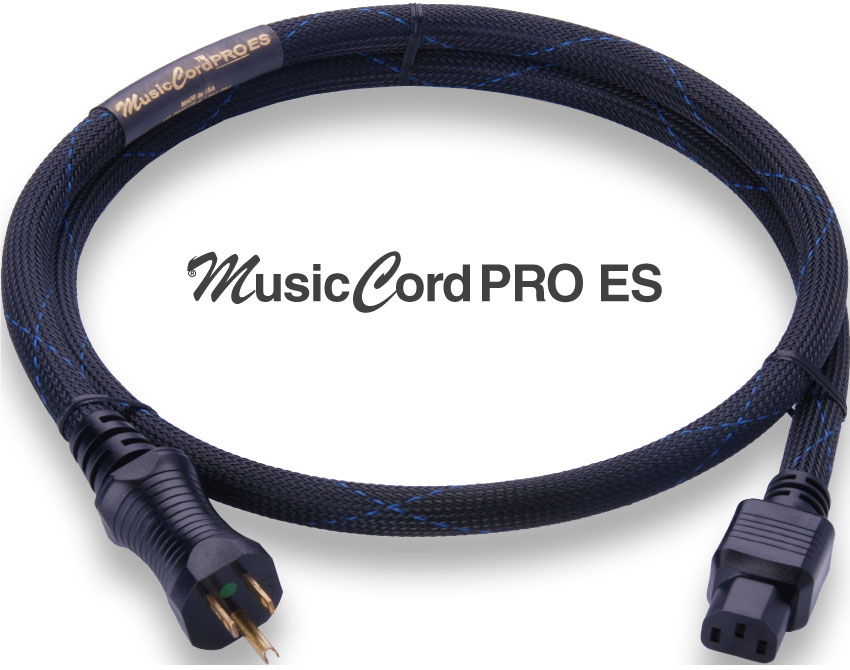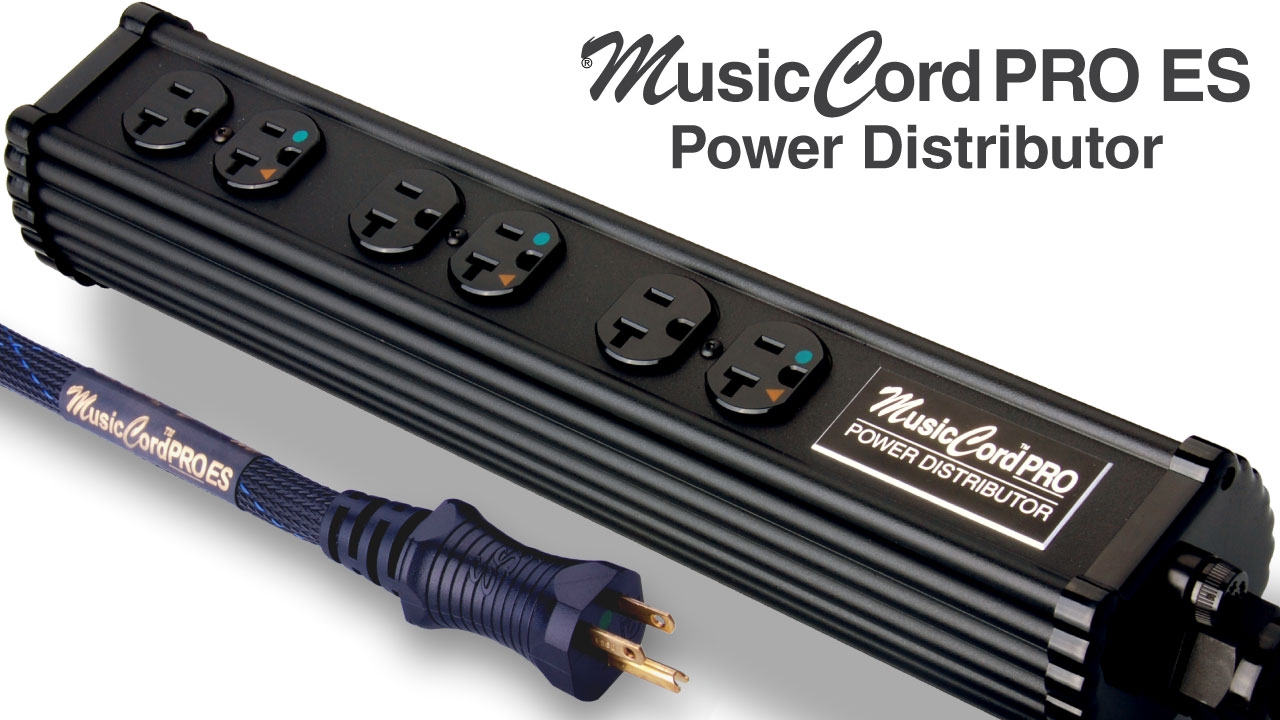Essential Sound Products (ESP) is a specialist manufacturer in the purest sense of the term. For more than a decade, Michael Griffin, the head of ESP, has designed and manufactured power cords and power distributors, and only a few examples of each. For the longest time, in fact, his product line consisted of just two products: the Essence power cord and power distributor. Over the past couple of years, Michael has expanded his catalog to include the MusicCord PRO and MusicCord ES series. The former helped ESP attain success in the pro-audio world, bringing its products to musicians and production facilities alike, while the latter brought the cost of entry to ESP’s products down to a much lower level.
The MusicCord-PRO ES line brings together elements of ESP’s two lower-cost lines while attempting to bridge the gap between them and the company’s current pièce de résistance, the Essence Reference. The MusicCord- Pro ES power cord shares the same basic geometry with the Essence Reference, with similar conductor sizes and spacing. However, to provide greater suppleness and allow for mass-produced terminations,

the MusicCord-PRO ES uses stranded live and neutral conductors, whereas for the Essence Reference these are solid. Griffin concedes that solid conductors are “ideal” sonically, so to bring his stranded conductors closer to this ideal, the MusicCord-PRO ES uses a process called “compacted stranding.” This involves drawing the stranded conductors through a circular press, which compacts them, causing more intimate contact among the strands. This process is commonly used for voicecoil windings and results, according to Michael, in “a conductor section that more closely resembles and performs like a solid round conductor.”
Terminations for the MusicCord-PRO ES are molded, versus the hand-wired terminations for the Essence Reference. While this makes for cost savings in terms of parts and labor, the up-front cost of the tooling for the multiple plugs (including Schuko and UK versions) and IEC connectors (with and without 90-degree bends) absorbs this to a great degree. There is also a level of design expertise required -- one doesn’t simply pick molded power-cord terminations from a catalog -- which probably explains why so few makers of power cords follow this path. For the MusicCord-PRO ES, terminations are crimped and soldered, providing the advantages of both. Crimped terminations don’t cause the damage to the conductors that screw-in terminations can, and they are much more consistent. Solder strengthens the joint, ensuring that it can take the stress of heat, weight and vibration.
There is also a very practical byproduct of the molded IEC termination of the MusicCord-PRO ES. It’s somewhat soft and extremely grippy, so it stays put in the component better than any hand-wired connector I’ve encountered. The molded terminations, which are solid material, also provide a level of mechanical damping for the cord at both ends, minimizing the creation and effect of eddy currents. After construction, each cord is cryogenically treated to minus 300 degrees Fahrenheit. While it is commonly believed that there are fewer grain boundaries after cryogenic treatment, Michael Griffin argues that there are, in fact, more boundaries. What cryogenic treatment does, therefore, is create such internal pressure that grains realign for better surface-to-surface contact. Michael Griffin: “Bottom line, electrically, is that cryogenic treatment has close to the same effect as if it were eliminating grain boundaries altogether -- lower resistance, and more current with fewer distortion effects.” The cords are also constrained layer damped, making them resistant to squishing or radial compression, a fine touch that increases durability and, Michael also finds, improves performance.
The MusicCord-PRO ES power distributor is also cryogenically treated stem to stern. It features a trio of hospital-grade outlets, each of which is wired back to the unit’s attached power cord, not daisy-chained to the outlet next to it. Daisy-chaining is easier, but wiring to the power cord effectively isolates each outlet from the others.
The power distributor does just what its name implies -- disburses power to the six products plugged into it -- as well as provides overload protection via a twostage system incorporating surge/spike protection between the hot and neutral legs of the circuit and a fastblow ceramic fuse. The unit’s anti-resonant, RFI-shielded aluminum chassis is filled with a proprietary damping material to encapsulate the internal wiring and coat the chassis walls, damping and thus mitigating the effects of airborne and structurally transmitted vibration. The captive MusicCord-PRO ES power cord provides the power cleansing, not an array of esoteric filters, an isolation transformer, or a power-regeneration circuit. The MusicCord-PRO ES distributor is not so much basic as hot-rodded for pure power throughput.
I suppose the point of all this is that when you make power cords and power distributors for nearly 15 years, as ESP has done, your design process evolves. Even so, in the case of ESP, evolution has never turned into an about face, so the power cords and distributors made today remain the products of the beliefs with which Michael Griffin literally founded his company. That sort of consistency of approach should reassure even the most jaded audiophiles.

The value of value
By our very nature, we humans strive to attain the greatest value for every dollar we spend. No one likes to spend frivolously, getting little or nothing in return for a given outlay of money. For that subspecies known as audiophiles, however, the value proposition doesn’t always follow a logical path. Products that offer high value cost much less than their competitors and outperform them as well. However, rarely are they considered alternatives to the highest-performing, highest-cost products, perhaps because they don’t reach the same sonic heights - - or, more likely, because it’s impossible to get some audiophiles to believe they do. To a layperson, it’s difficult to make the case that a $300 power cord can represent high value. To the audiophile, it’s difficult to make the case that a $300 power cord can represent the highest in performance.
It’s into this perceptual minefield that the MusicCord-PRO ES falls. At its price, it’s a power cord that naturally gravitates toward use with modest or mid-level equipment, but its performance suggests much higher aims. Discovering this, however, required great diligence and more listening than an amplifier or speaker would -- for a couple of important reasons.
First, I wanted to use the MusicCord-PRO ES power cords and Power Distributor I received with both of my systems -- the pricey main rig and my budget-minded office system -- in order to determine if these reasonably priced cords could cut it with a wide selection of components at varying price levels.
There was also the matter of break-in -- not so much of the cords and distributor themselves, but of the equipment with which they would be used. Michael Griffin is adamant that the components used with his products break in over time. “The power supply of the component (mostly the capacitors) that you attach the cord to undergoes additional break-in due to the enhanced dynamic capabilities,” he told me a few years ago. Furthermore, according to Michael, switching equipment off causes the capacitors to return slowly to their pre-broken-in state. Fortunately, “slowly” means over the course of days or weeks, so you can avoid the drudgery of re-break-in if you use your system regularly.
Of course, it’s impossible to test the claim of component break-in, but my experience with many ESP products suggests that there is something to it. Fresh out of the box, the various EPS power cords and power distributors I’ve used displayed a characteristic darkness that prominence in the uppermost treble, which was also present, offset -- intellectually if not actually. This two-pronged sonic signature left much to be desired, but the components submitted in short order, with both the darkness and prominence smoothed over after a few days of use.
I began using a couple of the MusicCord-PRO ES cords along with the power distributor in my office system, which is decidedly modest, though with mid-level aspirations. After ample use and break-in, the effect was easily recognizable and profound. There seemed to be greater power available, perhaps because the entire presentation was cleaner and more resolved, the music sounding quicker into and out of each note.
Mixing and matching components, some with captive cords that were plugged into the MusicCord-PRO ES Power Distributor, ensued, and the results were familiar: murkiness early on paired with brightness in the highest frequencies followed by improved clarity and greater resolution.
The value of the MusicCord-PRO ES cords and distributor, even among components costing much less than they do (most in my office system were bought at garage sales) was unequivocal in a sonic sense, and it urged moving the lot of them over to my dedicated listening room, where they would go from being more expensive than much of the associated gear to being by far the least expensive part of the system. After allowing for that break-in period, I heard much the same transformation, although with many defining subtleties added for good measure. The clarity and resolution remained, but their antecedents changed depending on the electronics with which the ESP products were used.
With Audio Research tube gear, for instance, some tonal saturation was traded for what seemed like greater transparency, especially in the treble and midrange. Each note from piano sounded more singular, better delineated from the others and the output of the rest of the instruments. I’ve been reading Robin D.G. Kelley’s exhaustive biography of Thelonious Monk, and it has caused me to listen to more of Monk’s work in the process. I have a nice mono LP of Thelonious Monk at the Blackhawk [Riverside 12-323] that sounded positively athletic with the MusicCord-PRO ES products,
Monk’s unpredictable phrasing benefiting from the speed with which the power cords and power distributor imbued the music.
Voices, from Ella Fitzgerald to Greg Brown, were slightly less physical and at the same time quicker off the mark, projecting more readily into the immense soundstage that Audio Research products conjure as a matter of course. When I switched from the Audio Research Reference 110 stereo amp to Atma-Sphere MA-2 Mk 3.1 monoblocks, which use two power cords each, the midrange was more see-through than I’ve ever heard in my system -- or any other. If you’re familiar with the Atma-Sphere amps, you know that this is one of the things they do, yet the MusicCord-PRO ES products were a match for it, revealing spatial cues and vocal inflections on the Speakers Corner reissue of Ella Fitzgerald’s Clap Hands Here Comes Charlie [Verve/Speakers Corner V6-4053] in a more elemental -- some might even say stark -- way.
With various pieces of digital gear, the MusicCord-PRO ES cords and distributor were so unfettered and pure in the treble and midrange that they should be considered standard equipment. The Audio Research Reference CD8 sounded more fleet and, almost impossibly, more spacious, while the Ayre DX-5, which I’ll be writing about soon, was better able to differentiate the various digital formats it can accommodate.
Here, the most interesting juxtaposition was between DVD-A and SACD, once the two battling tops of high-resolution digital. Neither of them won the format war between them, although it’s clear that SACD has had greater staying power: DVD-A is essentially kaput, while new SACDs continue to appear. I won’t tread on my upcoming review of the DX-5 except to say that SACD sounded more like analog, a distinction the ESP products helped to uncover.
While owners of these digital products may be apt to use more expensive power cords with them, I’d pay the $300 for the MusicCord-PRO ES and spend the rest on new music. Downloading may be accelerating, but once you hear a well-done Blu-ray disc through the DX-5 or an XRCD through the CD8, you may be convinced that old-school digital is still pretty impressive.
After weeks of switching and swapping power cords in my main system, I lugged the ESP products back to the office for some final assessment -- then back to the main system again. They covered all of the value bases like no other products -- even electronics or speakers -- I’ve heard. They demonstrated their worth in a modest system, but it was with cost-no-object electronics that they proved their real value, refreshing the performance of familiar amps, preamps and digital players that I thought could never surprise me.
Facing The Music
I have many years of experience with Michael Griffin’s products -- all the way back to the original Essence power cord, which I reviewed twelve (!) years ago. If you’ve studied the “Associated Equipment” boxes for the reviews I’ve been writing here at The Audio Beat, you’ve noticed that I use ESP’s top-of-theline Essence Reference power cords ($999) and power distributor ($1999) in my reference system. Thus, I’m not just familiar with what ESP products accomplish in strict musical terms, I have found them useful when it comes to reviewing, as they have always helped me hear what’s really happening - - provided the components were allowed to acclimate to them.
Even with all of this experience, I have to say that the MusicCord-PRO ES power cords and power distributor are the most impressive ESP products I’ve used. They are not the very best in strict sonic terms; The Essence Reference demonstrates much of the same clarity and resolution as the MusicCord-PRO ES, adding dynamic and bass prowess -- these depending on the partnering equipment -- that the latter doesn’t quite equal. However, the MusicCord- PRO ES products cost less than half of The Essence Reference, and more important they can be used in systems of the very highest pedigree -- and price - – as well as with modest electronics that are more commensurate with their cost. Such universality is the MusicCord-PRO ES’s overwhelming achievement.
Associated Equipment
Analog: TW-Acustic Raven AC turntable, Graham B-44 Phantom Series II and Tri-Planar Mk VII UII tonearms, Dynavector XV-1s (stereo and mono) and Audio-Technica AT33EV cartridges, AudioQuest LeoPard phono cable, Allnic Audio H-3000V and Audio Research Reference Phono 2 phono stages.
Digital: Audio Research Reference CD8 CD player, Ayre Acoustics DX-5 universal player, Oppo Digital DV-980H universal player.
Preamplifier: Audio Research Reference 5, Convergent Audio Technology SL-1 Legend.
Power amplifiers: Atma-Sphere MA-2 Mk 3.1 monoblocks, Audio Research Reference 110 stereo amp, Lamm Industries M1.2 Reference and ML2.2 monoblocks.
Integrated amplifiers: TEAC A-1D, Virtue Audio TWO.2.
Receiver: TEAC Reference CR-H500T.
Loudspeakers: Tidal Sunray, Thiel CS3.7, Wilson Audio Sasha W/P.
Interconnects: AudioQuest William E. Low Signature, Shunyata Research Aeros Aurora-IC.
Speaker cables: AudioQuest William E. Low Signature, Shunyata Research Aeros Aurora-SP.
Power conditioners: Essential Sound Products The Essence Reference, Shunyata Research Hydra V-Ray Version II.
Power cords: AudioQuest William E. Low Signature, Essential Sound Products The Essence Reference, Shunyata Research CX-series (various).
Equipment rack and platforms: Silent Running Audio Craz_ 8 equipment rack and Ohio Class XL Plus2 platforms (under Lamm M1.2 amps), Harmonic Resolution Systems M3 isolation bases under digital gear.
Reprinted from The Audio Beat Magazine, June, 2011.
Learn More: MusicCord-PRO ES Power Cord
Learn More: MusicCord-PRO ES Power Distributor
For more info, contact
Essential Sound Products, Inc.
Tel: 248-375-2655
Email: info@essentialsound.com
Web: www.essentialsound.com


